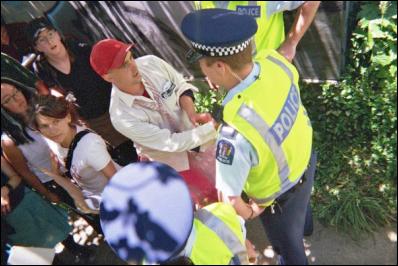Police Suppress Media At Anti-Bypass March
By 176 Multi-Media And Imcistas
Over 100 protesters marched through busy Wellington streets at Midday to challenge the construction of the Te Aro 'Bypass'. The mood of the protest was buoyant and defiant. As the march approached Tonks Ave, it became louder as police rapidly moved to obstruct protesters from walking through to Tonks Ave. As pushing escalated between police and protesters, the police quickly arrested the media who were closest to action.

A TV3 cameraman and a photographer for the Wellingtonian newspaper were violently arrested as they recorded the stand-off. The TV3 cameraman was later charged with Assaulting a Police Officer - who was attempting to confiscate his camera, while the photographer has been charged with Obstruction. There were repeated demands made by the police to "stop taking photographs". The marchers then broke off and ran to a side entrance to Tonks Ave., but were again greeted by police. A stand-off developed as a number of protesters challenged the police's right to obstruct access to what they believed was a public access way. Police assaulted two people as they gathered outside the Stagecraft Theatre. A man pushed off a 2 metre ledge and a woman was struck in the stomach.
Although long-serving police liaison officer Paul Berry refused to answer the protester's questions at the time, as the crowd dispersed he did state that it was transit land. However, initial legal advice indicates that he was misleading the activists.
Protestors felt frustrated. Toni McPhail said "it's clear where we stand now, we're not allowed into the heart of Wellington, and one of the first examples of European settlement. The Police used unnecessary force, and escalated the situation."
Te Aro is the first area of European settlement in Wellington city. European settlers first landed in Petone in 1839, but after flooding and the 1855 earthquake, settlers started migrating towards Te Aro flats. Tonks Ave. is historically important as it is one of the last examples of early colonial working life in Wellington.
The connection between Shell and "Bypass" construction company Fulton Hogan was also raised by marchers. Shell is the majority shareholder with 37% of shares in the road construction company and their interest in building roads is obvious. Shell is responsible for serious human rights abuses in several countries.
The protest ended at Kensington St community gardens with free vegan soup and bread.


 Gordon Campbell: On Budget 2025
Gordon Campbell: On Budget 2025 Greenpeace: Regulatory Standards Bill Inflicts ACT's Far-Right Principles On Aotearoa
Greenpeace: Regulatory Standards Bill Inflicts ACT's Far-Right Principles On Aotearoa Rainbow Wellington: Rainbow Wellington Concerned By Reports Of Increased Abuse
Rainbow Wellington: Rainbow Wellington Concerned By Reports Of Increased Abuse ACT New Zealand: David Seymour's Budget Day Speech 2025
ACT New Zealand: David Seymour's Budget Day Speech 2025 Government: Minister Of Finance’s Budget 2025 Speech
Government: Minister Of Finance’s Budget 2025 Speech The Prosperity Deal: Govt Budget Has No Plan For AI Job Loss – Citizens Launch The Prosperity Deal As The Only Workable Alternative
The Prosperity Deal: Govt Budget Has No Plan For AI Job Loss – Citizens Launch The Prosperity Deal As The Only Workable Alternative Greenpeace New Zealand: Greenpeace Braced For ‘Scorched Earth’ Budget From Govt
Greenpeace New Zealand: Greenpeace Braced For ‘Scorched Earth’ Budget From Govt


